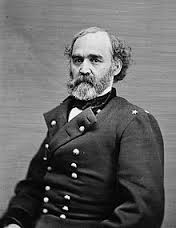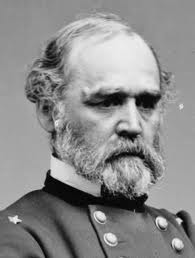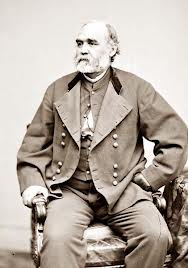 Meigs Quartermaster General, during the Civil War, was definitely an Unsung Union Hero. Meigs saw to the army’s equipment and supplies, as the army expanded from 16,000 men to more than 700,000 in the first year. His offices moved and housed the troops and supplied the guns and equipment needed for battlefield success, while at the same time keeping a watchful eye on the dishonest contractors that attempted to sell the government shoddy accoutrements. Secretary of State William Seward stated of Meigs,
Meigs Quartermaster General, during the Civil War, was definitely an Unsung Union Hero. Meigs saw to the army’s equipment and supplies, as the army expanded from 16,000 men to more than 700,000 in the first year. His offices moved and housed the troops and supplied the guns and equipment needed for battlefield success, while at the same time keeping a watchful eye on the dishonest contractors that attempted to sell the government shoddy accoutrements. Secretary of State William Seward stated of Meigs,
“Perhaps in the military history of the world there never was so large an amount of money disbursed upon the order of a single man. The aggregate sum could not have been less than fifteen hundred million dollars, accurately vouched and accounted for to the last cent, without the services of this eminent soldier the national cause must have been lost or deeply imperiled.”
Montgomery Cunningham Meigs, born in 1816, in Augusta, Georgia, was raised in Philadelphia, Pennsylvania. Meigs’ family, the father a prominent physician, was wealthy and well-connected socially and politically. As a youth, Montgomery Meigs attended preparatory schools and entered the University of Pennsylvania at the age of 15 years. He enrolled at the United States Military Academy in 1832 and graduated fifth in his class of 49, in 1836.
Upon graduation, Meigs was transferred to the Engineer Corps spending a quarter of a century, devoting his conspicuous ability to many important engineering projects including the Washington Aqueduct, wings and dome of the Capitol, and the Post Office Building.
Preceding the outbreak of the Civil War, Meigs and Lieutenant Colonel E. D.Keyes were quietly charged by President Lincoln and Secretary Seward with drawing up a plan for the relief of Fort Pickens, Florida., by means of a secret expedition. In April, 1861, together with Lieutenant D.D.Porter of the Navy, they carried out the expedition, embarking under orders from the President. On May 14, 1861, Meigs was appointed colonel, 11th Infantry, and on the following day, promoted to brigadier general and Quartermaster General of the Army.
 During the war, Meigs was so highly regarded that almost anyone who mattered listened to him. Upon receiving one report from Meigs, whose script was famously illegible, an admiring General Sherman said,
During the war, Meigs was so highly regarded that almost anyone who mattered listened to him. Upon receiving one report from Meigs, whose script was famously illegible, an admiring General Sherman said,
“The handwriting of this report is that of General Meigs, and I therefore approve of it, but I cannot read it.”
His brilliant services during the Civil War included command of Grant’s base of supplies at Fredericksburg and Belle Plain ,command of a division of War Department employees in the defenses of Washington at the time of Early’s raid, personally supervising the refitting and supplying of Sherman’s Army at Savannah and at Goldsboro and Raleigh, N.C. and reopening Sherman’s lines of supply. He was breveted major-general on July 5, 1864. General Meigs organized the department into 9 separate organizations, animals, clothing, transportation, forage, barracks, hospitals, wagons, inspection, and finance and by the end of the war employed 130,000 at depots strategically located across the north.
Meigs worked tirelessly to fight fraud and spend taxpayer money wisely. He loathed slavery and saw something almost biblical in the unfolding struggle. Meigs wrote his son Robert,
“God for our sins leads us to victory through seas of blood.”
Lincoln valued Meigs’ competence in organizing Union supply operations and his advice on military affairs. The president commented that Meigs only came to the White House when “he has something to say worth hearing.”
In January 1862, Meigs suggested that McClellan’s typhoid was likely to sideline him for six weeks and that Mr. Lincoln should meet with McClellan’s top division commanders to prepare for both a defense and attack. The President subsequently arranged several meetings with Meigs, William H. Seward, Salmon Chase, Assistant Secretary of War Thomas A. Scott, and Generals Irvin McDowell and William Franklin. After these conferences with his subordinates, McClellan recovered sufficiently to assure the President that his army would soon be in motion.
General Meigs recommended that property in Arlington, Virginia owned by Mary Custis Lee, the wife of Robert E. Lee, be used as a military burial ground. Based on this recommendation, Arlington National Cemetery was created in 1864. That October, Meigs’ son, John Rodgers Meigs was shot and killed in the Shenandoah Valley in an incident that his father regarded as murder. He had his son’s body laid to rest at Oak Hill Cemetery in Washington, D.C. The body was later moved to Arlington National Cemetery, a statue of the young lieutenant was cast exactly as he was found in the road, with his service revolver near his hand.
 As Quartermaster General after the Civil War, Meigs supervised plans for the new War Department building, the National Museum, the extension of the Washington Aqueduct and for a hall of records. In 1866-68, to recuperate from the strain of his war service, he visited Europe, and in 1875-76 made another visit to study the government of European armies. After his retirement on February 6, 1882, he became architect of the Pension Office Building. He was a regent of the Smithsonian Institution, a member of the American Philosophical Society, and one of the earliest members of the National Academy of Sciences.
As Quartermaster General after the Civil War, Meigs supervised plans for the new War Department building, the National Museum, the extension of the Washington Aqueduct and for a hall of records. In 1866-68, to recuperate from the strain of his war service, he visited Europe, and in 1875-76 made another visit to study the government of European armies. After his retirement on February 6, 1882, he became architect of the Pension Office Building. He was a regent of the Smithsonian Institution, a member of the American Philosophical Society, and one of the earliest members of the National Academy of Sciences.
Meigs died in Washington on January 2, 1892 after a short illness and his body was interred with high military honors in Arlington National Cemetery. The General Orders issued at the time of his death declared that,
“the Army has rarely possessed an officer. . .who was entrusted by the government with a great variety of weighty responsibilities, or who proved himself more worthy of confidence.”
Montgomery Cunningham Meigs, was not only a Quartermaster General, but a Great American and an Unsung Hero of the Civil War.
Bummer


Meigs was in his own way as important as Grant or Sherman to the Union war effort. His management of the quartermaster corps ensured the massive Northern advantages in manufacturing and supplies bore fruit on the battlefield. One thing confused me, though: was there reason to believe Meigs’ son was murdered over the federal grab of Lee’s property to create Arlington Cemetery?
Louis,
Think that Meigs may have played even a more important role in the Lincoln administration, in an advisory and strategy slot. Meigs was a task master, brilliant and didn’t suffer fools. Meigs was devastated by the loss of his son, theories and rumor exsist, haven’t read anything else. Great potential mystery scenario. Thanks as always.
Bummer
Meigs was certainly an interesting and extraordinary individual. Thanks for shedding some light on his role. Incidentally, I work in the building in Washington where Meigs had his HQ. It is right across from the Eisenhower Executive Office Building, where the War Department once stood, not far from the White House. Here is blog post I wrote on the building:
http://dclawyeronthecivilwar.blogspot.com/2011/04/guest-blogging-on-my-office-building.html
I believe that Meigs moved his HQ to what is now the Renwick Gallery in 1864.
Ron,
Thanks for the read! Bummer attempts to post every day. This “old guy” has never been to D.C. would be special to visit an area that has been studied for so long. Bummer and family now has the time to explore and experience the Eastern Theater for the first time. Thanks again for sharing and great blog post on your building.
Remaining,
Bummer
Thanks and my pleasure. Let me know if you make it out here–sounds like you might finally have the time!
Ron,
Visiting Eastern Tennessee this April and Virginia in the early fall. Will keep you posted.
Bummer
03/26/13 re:Historical Interest on Relief of Ft.Pickens, FL. A ‘secret’ mission was undertaken by Lt. John L. Worden (later Commanding Officer of the U.S.S. Monitor at the battle of Hampton Roads, VA on March 9, 1862) by train form Washington through the South to Pensacola, FL to deliver President Lincoln’s orders to land troops standing by in a Navy ship to relieve Fort Pickens. The orders were delivered, and the troops landed on April 12, the day of the attack on Fort Sumter.Had Worden failed, Fort Pickens might have been another first-day flashpoint of war and another loss for the Union.
John,
As Paul Harvey use to say, “Thanks for the rest of the Story”! Lincoln and friends were alot more stealthy than some might think. Subtle also. Thanks for sharing.
Remaining,
Bummer